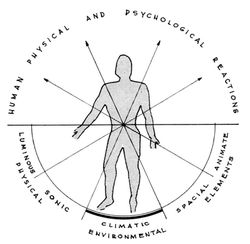 |
|---|
 |
 |
 |
 |
 |
|---|
 |
THERMOHELIODON

Victor and Aladar Olgyay, Princeton Architectural Laboratory, 1956
IS TEMPERATURE CONTROL KEY FOR MAN'S ENERGY LEVEL IN A CLOSED WORLD?
Immediately following World War II, at a time before mechanical heating, ventilation and air conditioning systems were available and affordable, there was a particular interest in developing design methods for architecture to respond to its climatic context. At the Princeton Architectural Laboratory, Aladar and Victor Olgyay were leaders in this field, having developed several methods and techniques to test architectural strategies of buildings’ placement and orientation in specific climate conditions.
Funded by the National Science Foundation, the Thermoheliodon was a domed insular test bed for architectural models at a small scale in specific climates calibrated to high levels of calculation and precision. The driving force behind the Olgyay brother’s research and the invention of the Thermoheliodon was the belief that architecture should create physiological conditions of human comfort, the main criteria of which is thermal temperature. Trained as modernists before emigrating to the U.S., the Olgyays spent their professional career exploring methods for adjusting the architectural design process to better assess the relationship between a building and its climatic surrounding (Barber, “The Thermoheilodon”). In his book Design With Climate: A Bio-Climatic Approach to Architectural Regionalism in 1963, Victor Olgyay wrote, “the architect’s problem is to produce an environment which will not place undue stress upon the body’s heat-compensation mechanism.” Stemming from a tradition in early modernism on calisthenics, balanced physical endurance and abundant oxygen, the Olgyays believed that man’s maximum productivity, physical strength and mental activity would be best at sync within a specific climate range. His drawing of the balanced man figure when situated in a comfortable temperature is illustrative of this belief and the motivations behind their research into techniques of calculation and calibration.
The Thermoheliodon was a closed simulating environment in which the thermal performance of building models could be tested under a range of temperatures. It consisted of two main elements, the testing apparatus and the instrument panel. A lamp moved around a curved path to model the arc of the sun. A set of fans behind an adjustable screen accounted for wind direction, while humidity was controlled by a series of jets. Within the Plexiglas dome, the architectural model was placed on soil from the building site to make for the most accurate measurements. However, achieving an accurate assessment was still problematic. Scale of materials was not recorded as an issue, allowing the focus to be on accuracy of orientation and shape. However, accomplishing dynamic and thermal similarity resulted in complications that compromised the effectiveness of the device. The Thermoheliodon, while failing to create an exact calculated environment, led to future studies on adaptive and efficient design orientation of buildings and formed the foundations of bioclimatic design principles.
KEYWORDS: THERMOCOUPLES, MONTH BRIDGE, LATITUDE RING, GALVANOMETER, COMFORT ZONE
KEY FAILURES
SCALING UP DISCREPANCIES: The dramatic scaling down of the model from the subject created inaccuracies in the results. The small scale of prototype performs differently to thermal heat than would the full scale subject.
